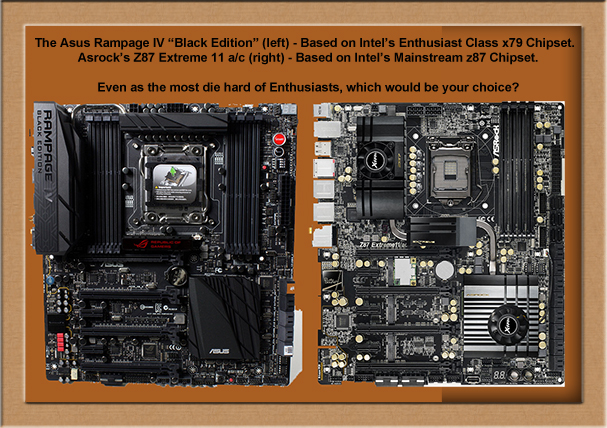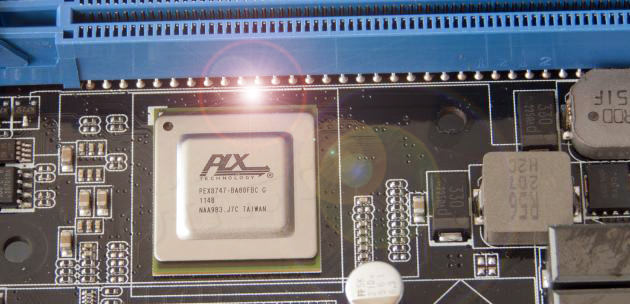


It was surely this which, when combined with the availability of sensational feats of micro engineering beyond Intel’s control, that permitted ravenously competitive clients such as Asus, Asrock, Gigabyte, MSI and others to formulate copious and eclectic methods of transforming a relatively spartan specification into a feature adorned, range topping slab of PCB heaven. A fitting example can be observed below:

On the right is the Z87 Extreme 11 A/C from Asrock, released as 2014 commenced. Beneath reams of glittering heat sinks and undulating rivers of circuitry, it did indeed harbour Intel’s basic chipset design, a design that warranted no more than x16 PCI-E lanes from the CPU and a further 8 from the PCH….and yet, we are examining a board boasting a quartet of full length, maximum bandwidth PCI-E 3.0 slots along with an breathtaking brigade of 22 sata ports. Where was all this extra bandwidth coming from? Nowhere, there wasn’t any, there was only one of these:

The PEX 8747, a chip manufactured by PLX, a company with no statuary obligation to Intel or any other.
An acceptable analogy might be to suggest that installing this chip on a motherboard is akin to having a super intelligent octopus directing traffic at a crowded intersection, the roads are not widened, the traffic is simply managed so efficiently that nothing ever grinds to a halt. In brief, this creation could ingeniously manipulate and deploy any chipset’s inherent bandwidth to wherever and whenever it was most beneficial with results stunning enough to enable Asrock and others to integrate an abundance of desirable bonus features.
By comparison, the motherboard on the left is Asus’s Rampage IV “Black Edition” is based on Intel’s Enthusiast class x79 chipset – six months the z87’s senior – and was released. The board itself was released a mere month prior to the Asrock. The most powerful CPU it could host was the six core 4960X.
And yet Compared to the Asrock married up to a 4970K Devil’s Canyon, it lacked thunderbolt support, Quicksync technology, had no native USB 3.0 controller and only two native SATA 6G ports.
It might well have offered quad channel memory, greater inherent PCI-E bandwidth, and even sported the same PLX chip as the Asrock. Though in all but a few applications that fully exploited all twelve of the Ivy Bridge-Es data crunching threads, it provided inferior performance. One might think it a little unfair to compare a newer mainstream platform with an ageing one for the enthusiast, though a six month interval between designs is hardly an eternity.
Thus, a worthy argument could be made that where the X58 had kept Enthusiasts satisfied for three of the Earth’s turns around the sun, it’s successor had initially been greeted with scepticism and surpassed in performance and value well before its abdication, by a progressively luxurious mainstream product line.
What if anything could Intel do to ensure a decreasing and disgruntled mob of Enthusiasts would once again be prepared to bust the bank in the name of pride?